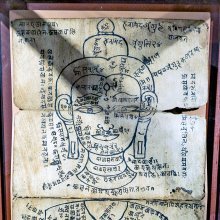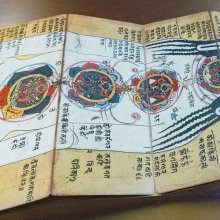Thyasaphu: 2 definitions
Introduction:
Thyasaphu means something in the history of ancient India. If you want to know the exact meaning, history, etymology or English translation of this term then check out the descriptions on this page. Add your comment or reference to a book if you want to contribute to this summary article.
Images (photo gallery)
India history and geography
Source: Wisdom Library: India HistoryThyasaphu refers to an “accordion-folded manuscript” or “handwritten manuscript” in Nepal; sometimes dating to Malla period.
Source: academia.edu: A Thyasaphu: Identifying Deities via Ritual andPilgrimageThyasaphu refers to a type of manuscript found in Nepal.—History of writing and drawing was carried out from the stone age. Different materials were then used e.g. rock, stone, stone pillar and later in metal, copper plate, gold plate, Palm-leaf, Betula utilis, papyrus, skin and papers. Specific type of writing that got famous in Nepal is thyasaphu, generally known as Manuscript. Reason this is called thyasaphu is that it uses a folding system to turn pages. “Thya” means to fold and “saphu” means book. Manuscripts are a source of information

The history of India traces the identification of countries, villages, towns and other regions of India, as well as mythology, zoology, royal dynasties, rulers, tribes, local festivities and traditions and regional languages. Ancient India enjoyed religious freedom and encourages the path of Dharma, a concept common to Buddhism, Hinduism, and Jainism.
See also (Relevant definitions)
Relevant text
No search results for Thyasaphu; (plurals include: Thyasaphus) in any book or story.

